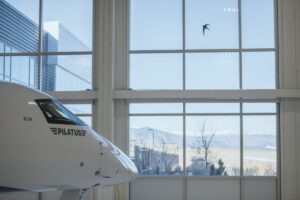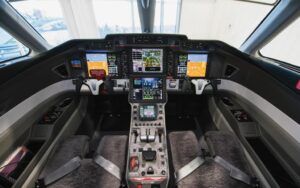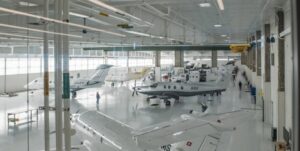Pia Bergqvist from Flying Magazine – Reports
When the early morning sun crests over the high plains, it lights up the headquarters of Pilatus Business Aircraft, Ltd., which sits near the Rocky Mountain foothills in the northwest Denver suburb of Broomfield, Colorado. Located at the approach end of Runways 12R/L at the Rocky Mountain Metropolitan Airport (KBJC), the modern aircraft facility finishes and delivers the Pilatus PC-12 turboprop andPC-24 Super Versatile Jet, manufactured by Swiss airplane maker Pilatus Aircraft, to North and South American customers.
The roots of Pilatus Business Aircraft, also known as PilBAL, sprouted with the help of Chris Finnoff, alongtime turboprop sales guru who founded Turbo West Aviation, and sold various types of aircraft before turning his focus on the Pilatus PC-12. The first PC-12 was brought to the U.S. in 1994—the same year it achieved both Swiss and FAA certification—and the Broomfield facility opened in 1996 as a parts and distribution source for North American dealers.

Pilatus Business Aircraft, Ltd. sits on a mesa near the foothills of the Rocky Mountains in the northwest Denver suburb of Broomfield, Colorado . [Credit Glenn Watson]
By 1997, PilBAL started interior installations, and in 2001, avionics options were installed in Broomfield.The capability allowed customers to make their final avionics selections later in the purchasing process, and, in those days, there was a wide variety of choices through field approvals.
When I first stepped foot in PilBAL’s facilities in 2017, the administrative offices were located in the airport terminal, while the avionics, parts inventory, flight operations, and interior fabrication and installation were spread across 14 hangars. Pilatus Business Aircraft clearly needed a new home. While the company considered other cities, the management settled on a piece of land across the runway, and the new facility opened its doors in 2018.
“A lot of us felt like fish out of water for a while having such a nice facility to work in,” said Mike Rector,vice president of production. “I worked on about six iterations of this building over a period of 15 to 16 years before we finally got the board convinced to build it herein this final configuration.”
When the PC-12 was first introduced, Pilatus expected a total production run of about 300 units. Finnoff’s vision and the continuous expansion in Broomfield have certainly contributed to Pilatus’ success in business aviation. The company will soon celebrate its 2,000th PC-12 and 200th PC-24 delivery.
The Main Event
Stepping through the entrance of the 118,000-square-foot main building, you’ll find offices for marketing, customer support, technical support, warranty administration, parts sales, engineering, and quality management. The office areas have a clean European feel, with a dominance of light wood and aluminum materials. Most exterior walls have large windows, bringing in natural light and providing stellar views of the rugged mountains to the west and the Colorado plains to the east. Around the open office spaces are several tall tables where impromptu meetings often lead to good ideas and solutions to problems.
While the main aircraft production is in Stans, Switzerland, all airplanes for North and South American customers are completed in Broomfield. The airplanes are ferried with bare cabins, so a lot of ballast is needed to keep them within their weight and balance envelopes. It’s a great opportunity for transporting equipment between the two headquarters, but other ballast is often used, as I’ll learn later in our visit.
Once in the U.S., the final avionics configuration is completed, with a lot of options for processing cards, software loads, entertainment and communications systems, and hardware. The airplanes then move on to the paint facility before the interior is installed.
An outside vendor produces seat frames and foam. Seat coverings for the worldwide fleet of PC-24s are completed at the Broomfield facility, while those of the PC-12 are outsourced. PC-12 and PC-24 customers have six design lines to choose from, with a mixture of neutral earth tones. Customers can choose a scheme, mix and match, or put their own stamp on the interior design, which can extend a project several months as materials have to meet regulatory requirements, said Marie Marschner, the director of sales administration, who is also a flight instructor. Also, the lines on the seats and sidewalls must remain consistent.

Pilatus ferries the airplanes generally with a base exterior coat and empty cabins. Pilots wear immersion suits and bring other survival equipment for the flight. The pre-delivery airplanes are also used for intercompany transport. [Credit: Glenn Watson]
There are other restrictions as well. For example, the lower sidewalls in the cabin in the PC-12 can be covered with leather; however, the PC-24’s can’t. “The cows aren’t big enough,” said Marschner. Attention to detail with the leather materials is extremely high. Every square inch of a hide is carefully examined before putting it into the Zund cutting machine—another Swiss piece of perfection that maximizes the use of each hide. Then the pieces are meticulously fitted around the seats.
Despite the diligence that goes into each stage of the process, several inspections are conducted before the customer is brought in for the official delivery, accounting for why most airplanes have zero squawks.
Continuing the European theme, there is a large focus on sustainability. Tom Aniello, vice president of marketing at Pilatus Business Aircraft, said there are plans to power the buildings completely with solar. The cabinetry is transported from a company in Austria in large wooden containers specifically designed to minimize damage. Those containers are shipped back and reused. Leftover aluminum from production in Stans is used as ballast and then sold to recycling companies. “It pays for our company holiday party,” said Aniello.

Lasers are used to outline the paint scheme on the airplane before the areas are taped off and painted. [Credit: Glenn Watson]
Paint Facility
The newest phase of PilBAL is the paint hangar, which opened last year, with the first painted airplane rolling out at the end of October. PilBAL previously outsourced the paint projects to two shops. While the company was happy with the finished product, the outsourcing required additional project managers and pilots to fly the airplanes back and forth. So, bringing the process in house made sense.
The base coat is painted on prior to the transatlantic ferry flight. It is generally white, but it doesn’t have to be. Stripping down and repainting the base can take five to six weeks, said Marschner, so it’s best if the preferred base color is applied in Switzerland.
The final design is completed using CAD software. The 3D design is applied to each side of the airplane with a laser system, ensuring perfect symmetry. Paint technicians tape each line before applying the paint. “Even with the laser, there is still a fair amount of artistry that comes into bending tape,” said Marschner. For example, lines might have to be modified where there are interruptions in the fuselage, such as air vents.
The paint that covers the walls in the three paint bays can be peeled off as dirt is introduced. Every six months, the paint on the walls is replaced to ensure total cleanliness. Filtration systems also keep dust out. A mixing room will soon be available for mixing colors on-site rather than buying each particular color.
Just as with the interior completion, attention to detail is high. Any blemishes are sanded down and fixed. “We’ve had a very high expectation, setting the bar for what Pilatus aircraft look like when they come out of the paint shop,” Marschner said. “It’s a completely different standard than some of our competitors. So, with the new paint shop, we’re trying to achieve close to perfection with a very new shop, a new team, and new procedures. They’re doing a really outstanding job.”

With the integrated Honeywell Primus Apex system in the PC-12 and Primus Epic in the PC-24 , there is not as much of a need for avionics modifications in the PilBAL facility as there used to be. In the early years in Broomfield, Pilatus made major avionics modifications in the PC-12 through field approvals. [Credit: Glenn Watson]
Each leather hide is scrutinized to make sure there are no imperfections in the visible areas of the seats. A computerized cutting machine made by Zund, another Swiss company, ensures perfect execution and maximizes the cutting areas of each hide.

With the current layout, the completion hangar can fit up to 14 airplanes, with a capacity of at least 50 percent more. “The way it’s set up, we’ve got plenty of room to set up support equipment around the airplanes, and people have elbow room to work,” said Perry Schulz, director of completions. “It’s a good system that works.” [Credit: Glenn Watson]
The factory in Stans transforms leftover aluminum into ballast blocks used in ferrying aircraft. Marked with its weight, each has removable handles used to pick it up. Once in Broomfield, many aluminum blocks are recycled.
Get in touch
© Sentinel Aviation. Company No. 09400896. Vat No. 221163359.
All rights reserved. Created by AJA Design.
